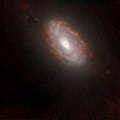NGC 23
| Galaxy NGC 23 |
|
|---|---|

|
|
| SDSS recording | |
| AladinLite | |
| Constellation | Pegasus |
|
Position equinox : J2000.0 , epoch : J2000.0 |
|
| Right ascension | 00 h 09 m 53.5 s |
| declination | + 25 ° 55 ′ 26 ″ |
| Appearance | |
| Morphological type | SB (s) from / HII / LIRG / Sbrst |
| Brightness (visual) | 11.9 likes |
| Brightness (B-band) | 12.8 mag |
| Angular expansion | 2.1 ′ × 1.3 ′ |
| Position angle | 174.2 ° |
| Surface brightness | 12.8 mag / arcmin² |
| Physical data | |
| Affiliation | NGC 23 group LGG 2 |
| Redshift | 0.015231 ± 0.000007 |
| Radial velocity | 4566 ± 2 km / s |
|
Stroke distance v rad / H 0 |
(212 ± 15) · 10 6 ly (64.9 ± 4.5) Mpc |
| history | |
| discovery | Wilhelm Herschel |
| Discovery date | September 10, 1784 |
| Catalog names | |
| NGC 23 • UGC 89 • PGC 698 • CGCG 477-62 • CGCG 478-34 • MCG + 04-01-033 • IRAS 00073 + 2538 • KUG 0007 + 256 • 2MASX J00095341 + 2555254 • Mrk 545 • GC 9 • H III 147 • GALEX ASC J000953.40 + 255524.9 • NVSS J000953 + 255526 | |
NGC 23 is an active bar-spiral galaxy with a high rate of star formation of the Hubble-type SBa in the constellation Pegasus in the northern sky . It is an estimated 212 million light years from the Milky Way and about 130,000 light years across . Together with NGC 26 , it probably forms a bound galaxy pair. She is a member of the galaxy group LGG 2 or NGC 23 group .
Recordings
False color display of the center of the galaxy, recorded with the NICMOS camera of the HST at 1.1 µm, 1.6 µm and 1.9 µm.
The supernova SN 1955C was discovered here.
The object was discovered on September 10, 1784 by the German-British astronomer Wilhelm Herschel .
NGC 23 group
| Galaxy | Alternative name | Distance / million Lj |
|---|---|---|
| NGC 1 | PGC 564 | 211 |
| NGC 23 | PGC 698 | 212 |
| NGC 26 | PGC 732 | 213 |
| PGC 912 | UGC 127 | 217 |
| PGC 619 | UGC 69 | 215 |
| PGC 654 | UGC 79 | 201 |
| PGC 830 | UGC 110 | 209 |
Web links
Commons : NGC 23 - collection of images, videos and audio files

